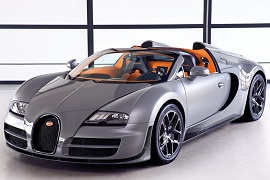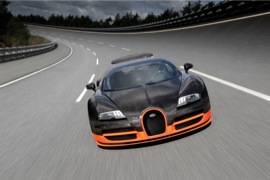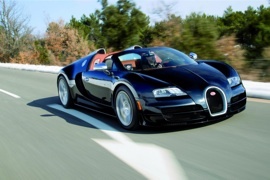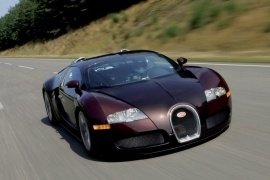BUGATTI Veyron Models/Series Timeline, Specifications & Photos
First production year: 2005
Engines: Gasoline
Body style: Coupé (two-door)
After launching the Bugatti 16.4 Super Sport, Bugatti started to receive questions if there is any chance to built an open-top version of the 1200 hp hypercar. And the answer was shown at the 2012 Geneva Motor Show.
The fastest way to transform a car into an open-top car is to remove its roof, without the side-pillars. That would transform the car into a Targa-vehicle. Even though, it had to be reinforced since there was no connection between the A-pillar and the B-pillar. And, when there is a 16 cylinder engine in the back that pushes with 1200 hp, it needs to be heavily reinforced.
The Grand Sport Vitesse was inspired by the Bugatti Type 37 A, a roadster from 1929 that featured half-doors and the back rear side of the cabin raised to the occupant's shoulders level. For the 2012 special edition, that was even higher, since the engine was in the back. A double-bulge on the engine compartment lid ensured a flowing aerodynamic and hosted the security arches as well.
As usual, the cabin featured two sport-bucket seats that were high bolstered to hold its occupants in place while hard-cornering. The Grand Sport Vitesse was able to withstand 1.4g lateral acceleration. A wind-stopper was available to be placed behind the headrests.
The engine featured four larger engines than the Grand Sport and it offered 199 more power than before. To cool the 7-speed (dual-clutch) automatic gearbox, there were new air-ducts around it.
A sportier Veyron that offered a more extreme driving experience, the Bugatti Veyron Super Sport unveiled in 2010 at the Monterey Motorsports Reunion was the fastest thing on wheels at the time.
Designed for the existing customers who were asking for a sportier version, the Veyron Super Sport was produced in 30 units only.
Besides increased power, the new model was actually different from the regular Veyron, with nearly 20%, featuring a completely different gearbox software, a new suspension, a new aero package, new tires, new wheels, updated brakes and many others.
The front end had been redesigned to allow more air to flow through the radiators as cooling for such a powerful engined needed improvement. At the rear, the Super Sport featured a new double diffuser for the new exhaust system.
Unimaginably fast, the Super Sport version got 200 extra ponies under its hood, reaching a total of 1200 hp. At lower speeds, the fast Veyron could have been considered docile, but its powerful engine rocketed it to a maximum of 415 km/h. And 415 km/h was the imposed limit, to avoid tire disintegration. The Super Sport was capable of 0-100 km/h in 2.5 seconds and 0-300-0 km/h in just 22.5 seconds.
You could expect that a vehicle as fast as the Veyron was, to offer a firm ride and probably a bit uncomfortable one. Unexpectedly, the Super Sport Veyron was very refined, as refined as the luxurious Bentley GT.
Inside, the cabin was refreshed and became even more exquisite and nicer than before, with a new leather steering wheel and other details.
The few lucky people who got to own the Veyron Super Sport had a vehicle that was not only extremely fast, but very comfortable and with a good value even after many, many years.
The 2009 Bugatti Veyron Grand Sport came as a roadster hypercar designed to destroy any other car on the road with its incredible performances.
Even though its open-top construction offered half the rigidity of its coupe sibling, it was stiffer than most coupes on the market due to its advanced composite construction that combined magnesium, aluminum, and carbon-fiber elements. Its engine was hand-made by two technicians and provided a minimum of 987 hp, but the carmaker was sure that most of them rocked the drivetrain with more than 1000 ponies. Yet, the Grand Sport was designed to be driven by almost anyone who could grab a steering wheel, see above the dashboard, and reach the pedals.
The exterior was not too much different from its coupe sibling, albeit it missed the polycarbonate roof provided with a Bugatti-branded display stand. The carmaker provided a standard, square umbrella in the front luggage compartment to be used in an emergency and fit in the roof's mounting points so it could stay in place at speeds of up to 80 mph (128 kph) without being rip-off by the wind. Behind the cabin, the carmaker added two safety arches followed by power domes that flanked the massive V-16 engine.
Its leather-clad interior featured two high-bolstered bucket seats separated by a tall center console, which also served as a transmission tunnel. There was no advanced touch-screen infotainment system: just an exquisite Puccini sound system and a five-dial instrument panel. The minimalist design was also pure and showed distinction.
The quad-turbocharged, eight-liter monster engine sent its power in all corners via a seven-speed automatic (dual-clutch) transmission. Bugatti acknowledged that the car achieved its maximum speed with the roof down, but the 0-100 kph (0-92 mph) time was the same, regardless of where the roof was.
It was the first production vehicle that featured over 1000 hp on the market and its price-tag was through the roof. But it was the fastest car on the planet and it established the benchmark for most of the hyper-cars: the Bugatti Veyron 2005 was, and still is, a beast on the road.
After Audi (Volkswagen Group) bought the Bugatti brand, its goal was to make the most astonishing supercar on the market. And so it did, when the Veyron appeared. Its massive bodywork, enormous power and strange quad-turbo on a W16 engine were a marvel of engineering. The short front and integrated greenhouse and engine compartment look were true special features for any vehicle.
The interior featured the best materials and finishes on the market. The only rival in this chapter was Rolls-Royce. The seats were both comfortable and supportive, with adjustable bolsters on the side. On the big, central console covered in aluminum, there are two air-vents, one dial and few buttons for the HVAC and one dial plus few buttons for the audio system. No fancy TFT or touch-screen there. The instrument cluster had only dials.
But the main feature of the car was the 1001 hp engine that was mated to a 7-speed dual-clutch gearbox developed especially by the F1 gearboxes manufacturer Ricardo, in the UK.



